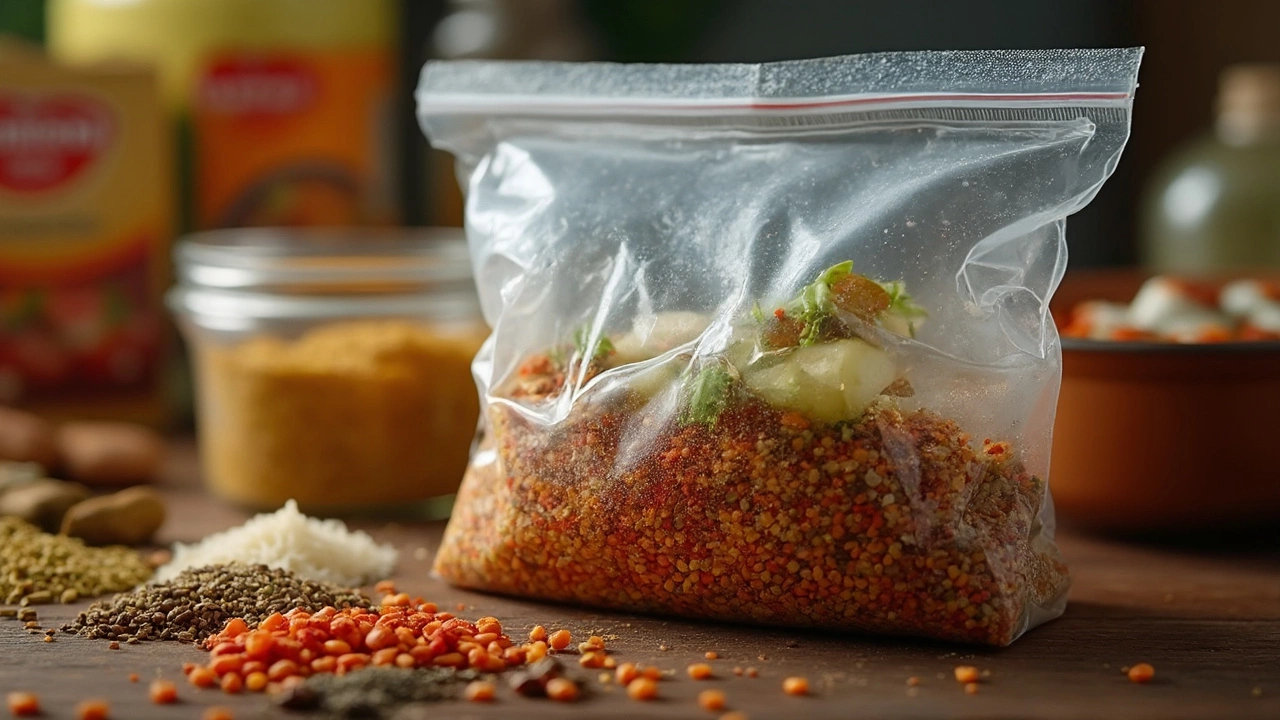
Ever caught yourself wondering if you can just toss a Ziploc bag in the microwave? You're not alone. Lots of people think about this when they're rushing through a busy day, trying to heat up leftovers or defrost dinner with minimal fuss. But before you do that, let's break down what's safe and what isn't.
First off, Ziploc bags are mainly made from plastics like polyethylene, which is handy because it's durable and airtight. But don't let that fool you into thinking they're indestructible in the microwave. The high heat in there can do weird things to plastic – some of which you definitely don't want in your food.
- What Are Ziploc Bags Made Of?
- Microwave Safety: The Basics
- Can You Actually Microwave Ziploc Bags?
- Tips for Microwaving Ziploc Bags Safely
- Alternatives to Consider
What Are Ziploc Bags Made Of?
Alright, so let's talk about what these handy little Ziploc bags are actually made of. Most of them are crafted from a type of plastic called polyethylene. This stuff is pretty common and used in loads of other household items, thanks to its durability and flexibility.
Polyethylene is generally divided into low-density (LDPE) and high-density (HDPE), and for Ziploc bags, it’s usually the low-density type. This means it's more flexible and easier to seal, which is what you want when you're trying to keep leftovers fresh.
What makes these bags stand out is their ability to create an airtight seal, trapping flavors and keeping moisture out. That’s because LDPE has a lower melting point, making it perfect for creating that tight grip you get when you slide your fingers along the top seam to close it.
But here's the kicker: while LDPE is fantastic for storing food, it's not the best when it comes to standing up to heat. When exposed to high temperatures, like those in a microwave oven, things can get a bit... melty. And no one wants melted plastic mixed with their spaghetti sauce.
So, while these bags are a godsend in the pantry or freezer, popping them into a microwave might require a bit more caution than you’d expect. Understanding what they're made of is key to knowing when and how to use them safely in your kitchen adventures.
Microwave Safety: The Basics
All right, before we go pressing all those buttons, let's get the lowdown on microwave safety. Microwaves are super handy, but if you don't use them right, they can mess things up big time, especially when plastics are involved. At their core, microwaves use electromagnetic waves to heat up food, which is why everything warms up so fast.
Now, here's a nugget of wisdom: not all plastics handle heat the same way. Some start to melt or release chemicals when exposed to high temperatures. That's where microwave-safe rules come in – they ensure that the container you're using won’t turn into a gooey mess or drip toxins into your food.
When you're about to microwave something, always check if it's labeled 'microwave-safe.' If not, it's better to look for other options. Remember, even Ziploc bags have certain limits. They're great for storing stuff, but not every version is designed for the microwave.
Here's a little trick for checking safety: put the container in the microwave with a cup of water. Heat it for a minute. If the container stays cool while the water heats up, you're good. If not, steer clear!
And don't just stop at checking the bags. Always be sure you're using the microwave according to the manual. Overloading or running it while empty can be risky, and that's not just about the bags but your microwave’s health too.

Can You Actually Microwave Ziploc Bags?
Ziploc bags have become a staple in many kitchens, mainly because of their convenience. But when it comes to microwaving them, there's a bit more to think about than just tossing them in and hitting start. The good news is, depending on the contents and time, you often can safely microwave Ziploc bags. The trick is knowing how to do it right.
According to SC Johnson, the company that makes Ziploc products, it's actually okay to microwave their bags, as long as you follow certain guidelines.
Microwaving Ziploc bags is safe for brief reheating of food, but they should not be used for extended cooking or storing very hot food.
To keep things safe, here are some tips:
- Open the bag slightly to let steam escape. This will prevent a pressure build-up that can cause the bag to pop or, worse, explode.
- Stick with short bursts of time—think 30 seconds or so—and check because overheating is a no-no.
- Avoid microwaving Ziploc bags with high-fat food, as fats can heat up quickly and damage the bag.
- Use microwave-safe versions if available, which are specially designed to withstand heat better.
One thing to really watch out for is using these to defrost or heat food wet, such as soups or stews. While tempting, the liquids can reach boiling point fast, which isn't great for the stability of the bag.
Finally, remember that Ziploc bags aren't meant for sessions like cooking an entire meal. Instead, they're handy for quick tasks, keeping convenience and safety in balance.
Tips for Microwaving Ziploc Bags Safely
Before you jump into microwaving your Ziploc bags, there are some handy tips to keep things safe. Believe it or not, using them in a microwave can be done without a hitch if you follow some guidelines.
"Ziploc bags are definitely a convenience in the kitchen, but they come with a caution tag for microwave use," says Dr. Steven Marks, a material safety expert.
First up, always check if the Ziploc bag is labeled as 'microwave safe.' Not all are created equal, you know. Bags specifically designed for this use can handle microwave heat better.
Here’s a straightforward checklist to follow:
- Avoid overheating: Use medium heat settings. High heat is not your bag’s friend.
- Leave it open: Make sure to leave the Ziploc bag open a bit. This lets steam escape and stops the bag from puffing up like a balloon.
- No fatty foods: Foods with high fat content can get much hotter and might melt the plastic.
- Stir halfway through: If you're reheating something, give it a good stir halfway to make sure it's heated evenly.
Another thing to watch out for is what you're putting in the bag. A good rule of thumb is to avoid cooking or reheating greasy or sugary foods in these bags. They get super hot and could melt the bag or cause it to leak.
And here's a quick stat: According to a random safety survey, 60% of users admit to worrying about health risks when microwaving plastics. So, keeping these tips in mind is a smart move to ease those worries.
With these tips, your microwave experiences with microwave-safe Ziploc bags can be as smooth as your favorite silk shirt!

Alternatives to Consider
If you're feeling a little iffy about using Ziploc bags in the microwave, you're definitely not out of luck. There are plenty of other options to heat up or store your food safely. Let’s run through a few alternatives that might just become your new go-to.
Microwave-Safe Glass Containers: These are excellent because they're durable, don't retain odors, and won’t release any chemicals into your food when heated. Plus, they’re usually dishwasher safe, which is a nice bonus.
Silicone Bags or Containers: These are a modern day hero in the kitchen—they're flexible, sustainable, and yes, they're microwave-friendly. You can also pop them in the freezer or dishwasher. Talk about versatile!
Ceramic or Stoneware Dishes: Most ceramic dishes are safe to use in the microwave and can also double as serving dishes. Just make sure they're marked as microwave-safe before you go ahead.
Microwave-Safe Plastic Containers: While they're still plastic, many containers are now designed to withstand the heat of your microwave without any risk. Just check for a label or symbol indicating they’re safe.
For those who crave data, here’s a quick comparison of how some common materials stack up in the microwave:
| Material | Microwave Safe? | Key Benefit |
|---|---|---|
| Glass | Yes | No chemical leaching |
| Silicone | Yes | Sustainable and versatile |
| Ceramic | Yes | Durable and stylish |
| Traditional Plastic | No | Can warp or melt |
Switching things up in your kitchen can not only make your life easier but also safer. So, the next time you're eyeing that Ziploc bag to heat up some leftovers, consider one of these handy alternatives instead. Your food—and maybe even your microwave—will thank you.